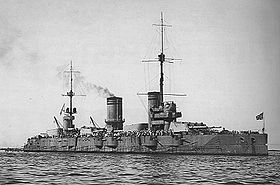Sevastopol (ship, 1911)
|
|
|
|---|---|

|
|
| Overview | |
| Type | Battleship |
| Shipyard |
Baltic shipyard, St. Petersburg |
| Order | 1908 |
| Keel laying | June 15, 1909 |
| Launch | June 29, 1911 |
| Namesake | Sevastopol city |
| Commissioning | November 1914 |
| Technical specifications | |
| displacement |
New building:
after reconstruction:
|
| length |
New construction: |
| width |
26.9 m |
| Draft |
New building: 8.3 m |
| crew |
1,125 men |
| drive |
|
| speed |
Max. 23.4 kn |
| Range |
4,000 nm at 16 kn |
| Armament |
12 × 305 mm-L / 52 -SK |
The Sevastopol was the third of four dreadnought liners of the Russian Gangut class . In addition to the Gangut, sister ships were the Petropavlovsk and the Poltava . The four units were the first Russian dreadnoughts. Since Russian shipyards had little experience in building modern capital ships, Italian, German ( Blohm & Voss ) and Scottish designs were requested, which ultimately led to a rather idiosyncratic design. The Sevastopol was laid down in St. Petersburg in 1909 , launched in October 1911 and completed in November 1914. During the First World War she served in the Baltic fleet of the Russian Navy . After the Soviet Revolution, it was renamed Parishskaya Kommuna ( Paris Commune ).
period of service
Since all Russian dreadnoughts in the Black Sea were lost in the First World War or in the following civil war , the ship was moved from the Baltic Sea to the Black Sea between December 1929 and January 1930 in order to strengthen the Black Sea Fleet there. Here, however , the ship got into severe storms in the Atlantic and suffered considerable sea damage (a result of the relatively lightly constructed formations), including a ten-meter-long section of the bow was torn off. As a result, the ship had to call at Brest as an emergency port, where a new, sickle-shaped bow segment was added as part of an emergency repair.
Between 1936 and 1939, the ship in Nikolajew was modernized, with the forecastle strengthened and increased by one deck, and the Parischskaja Kommuna received new smoke outlets and twelve new, now purely oil-fired boilers. The oil supply was around 2,100 tons. By the summer of 1941, the number of anti-aircraft guns was also significantly increased, with a relatively large number of different calibers being housed on board, so from 1941 there were a total of six 7.6 cm anti-aircraft guns 34-K , twelve 4.5- 21-K cm anti-aircraft guns, ten to twelve 3.7 cm rapid-fire 70-K cannons (a marine variant of the 61-K version) and 16 heavy 12.7 mm anti-aircraft machine guns on board.

After the German attack on the Soviet Union on June 22, 1941, the Parischskaya Kommuna was used several times in bombardment missions, for example the battleship with its heavy artillery intervened in the battle of Odessa in October 1941 . After the rapid advance of the Axis Powers at the end of October 1941 had made it necessary to move the ship to Novorossiysk , the Parishskaya Kommuna again fired at advancing German troops off Sevastopol in November and December 1941 . In January 1942, the battleship also participated in the ultimately unsuccessful Kerch-Feodosia operation and supported the Soviet troops landed on the Kerch peninsula several times with heavy artillery. A last use of the ship against German troops took place in March 1942 at Feodosiya .
The ship then moved, as the heavy 30.5 cm gun barrels had been shot out and urgently needed to be replaced, to Poti for an overhaul. As a result of the critical course of the war in 1941 and 1942 for the Soviet Union, and also because the army troops were given general priority in supply at that time, the new pipes could not be delivered immediately, so that the ship remained inactive in Poti until the summer of 1944, whereby on May 31, 1943 it was renamed Sevastopol again. After the new gun barrels could be installed in the summer of 1944 (the ship also received an aerial warning radar supplied by Great Britain), the battleship returned to the conquered Sevastopol in November 1944 .
After the end of the war in 1945, Sevastopol was awarded the Order of the Red Banner for her missions in 1941/42 and then used as a training ship until 1954. Removed from the fleet list and decommissioned in February 1956, the battleship was finally scrapped in 1957.
Individual evidence
- ^ Siegfried Breyer: Battleships and battle cruisers 1905-1970 . JF Lehmanns Verlag, Munich 1970, p. 417f.
- ↑ Breyer: Battleships , p. 417f. (see drawing).
literature
- Siegfried Breyer: Battleships and battle cruisers 1905–1970 . JF Lehmanns Verlag, Munich 1970, ISBN 3-88199-474-2 .